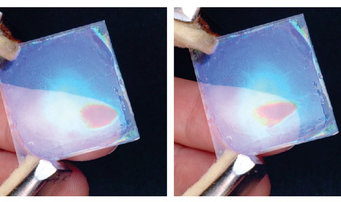Touchless displays superseding touchscreens?
Touchless displays could react to moisture emitted by the human body

A touchless display may be able to capitalize on a human trait which is of vital importance, although sometimes unwanted: This is the fact that our body sweats – and is constantly emitting water molecules through tiny pores in the skin. Scientists of the Nanochemistry group led by Bettina Lotsch at the Max Planck Institute for Solid State Research in Stuttgart and the LMU Munich have now been able to visualize the transpiration of a finger with a special moisture sensor which reacts as soon as an object - like an index finger – approaches its surface, without touching it. The increasing humidity is converted into an electrical signal or translated into a colour change, thus enabling it to be measured.
Phosphatoantimonic acid is what enables it to do this. This acid is a crystalline solid at room temperature with a structure made up of antimony, phosphorous, oxygen and hydrogen atoms. “It’s long been known to scientists that this material is able to take up water and swells considerably in the process,” explained Pirmin Ganter, doctoral student at the Max Planck Institute for Solid State Research and the Chemistry Department at LMU Munich. This water uptake also changes the properties of the material. For instance, its electrical conductivity increases as the number of stored water molecules rises. This is what enables it to serve as a measure of ambient moisture.
A sandwich nanomaterial structure exposed to moisture also changes its colour
However, the scientists aren’t so interested in developing a new moisture sensor. What they really want is to use it in touchless displays. “Because these sensors react in a very local manner to any increase in moisture, it is quite conceivable that this sort of material with moisture-dependent properties could also be used for touchless displays and monitors,” said Ganter. Touchless screens of this kind would require nothing more than a finger to get near the display to change their electrical or optical properties – and with them the input signal – at a specific point on the display.
Taking phosphatoantimonate nanosheets as their basis, the Stuttgart scientists then developed a photonic nanostructure which reacts to the moisture by changing colour. “If this was built into a monitor, the users would then receive visible feedback to their finger motion” explained Katalin Szendrei, also a doctoral student in Bettina Lotsch’s group. To this end, the scientists created a multilayer sandwich material with alternating layers of ultrathin phosphatoantimonate nanosheets and silicon dioxide (SiO2) or titanium dioxide nanoparticles (TiO2). Comprising more than ten layers, the stack ultimately reached a height of little more than one millionth of a metre.
For one thing, the colour of the sandwich material can be set via the thickness of the layers. And for another, the colour of the sandwich changes if the scientists increase the relative humidity in the immediate surroundings of the material, for instance by moving a finger towards the screen. “The reason for this lies in the storage of water molecules between the phosphatoantimonate layers, which makes the layers swell considerably,” explained Katalin Szendrei. “A change in the thickness of the layers in this process is accompanied by a change in the colour of the sensor – produced in a similar way to what gives colour to a butterfly wing or in mother-of-pearl.”
The material reacts to the humidity change within a few milliseconds
This is a property that is fundamentally well known and characteristic of so-called photonic crystals. But scientists had never before observed such a large colour change as they now have in the lab in Stuttgart. “The colour of the nanostructure turns from blue to red when a finger gets near, for example. In this way, the colour can be tuned through the whole of the visible spectrum depending on the amount of water vapour taken up,” stressed Bettina Lotsch.
The scientists’ new approach is not only captivating because of the striking colour change. What’s also important is the fact that the material reacts to the change in humidity within a few milliseconds – literally in the blink of an eye. Previously reported materials normally took several seconds or more to respond. That is much too slow for practical applications. And there’s another thing that other materials couldn’t always do: The sandwich structure consisting of phosphatoantimonate nanosheets and oxide nanoparticles is highly stable from a chemical perspective and responds selectively to water vapour.
A layer protecting against chemical influences has to let moisture through
The scientists can imagine their materials being used in much more than just future generations of smartphones, tablets or notebooks. “Ultimately, we could see touchless displays also being deployed in many places where people currently have to touch monitors to navigate,” said Bettina Lotsch. For instance in cash dispensers or ticket machines, or even at the weighing scales in the supermarket’s vegetable aisle. Displays in public placesthat are used by many different people would have distinct hygiene benefits if they were touchless.
But before we see them being used in such places, the scientists have a few more challenges to overcome. It’s important, for example, that the nanostructures can be produced economically. To minimize wear, the structures still need to be coated with a protective layer if they’re going to be used in anything like a display. And that, again, has to meet not one but two different requirements: It must protect the moisture-sensitive layers against chemical and mechanical influences. And it must, of course, let the moisture pass through. But the Stuttgart scientists have an idea for how to achieve that already. An idea they are currently starting to put into practice with an additional cooperation partner on board.
KH
